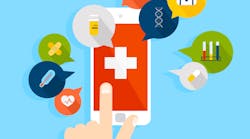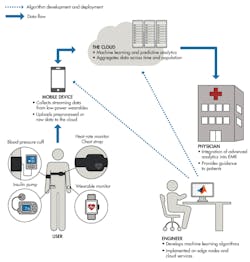Download this article in PDF format.
Trends like artificial intelligence (AI), neural networks, cloud computing, machine learning, deep learning, wearables, and Internet of Things (IoT) are defining a new technological era. While one can’t be blamed for thinking this might be more hype than substance, the changes emerging from these trends are quite real.
The traditional healthcare system has enormous amounts of patient data (medical records, images, videos, and ICU signals) funneling into predictive-analytics systems that learn and detect trends to improve patient care. Besides collecting medical data at the point-of-care (at hospitals and clinics), engineers and scientists can now acquire, store, and work with large amounts of data from wearable medical devices in ways that weren’t conceivable even 10 years ago.
With all of this data, though, comes the very real challenge of transforming it into actionable insights. Often, this involves applying some of the latest analytics to your data to develop an innovative product or service that positively affects patient outcomes and delivers commercial growth. Beyond that, getting your product or service approved, and then quickly pushing it out into to the market, becomes another significant challenge.
Key enablers of success in overcoming these challenges are engineering software tools like MathWorks' MATLAB. They let medical-device engineers and researchers prototype and implement advanced algorithms, analyze large amounts of varied types of data quickly and effectively, and develop/deploy new machine-learning models without coding them from scratch.
How the Landscape Looks
To better understand this Big Data challenge, you can view this emerging landscape using two different perspectives: the IoT system framework along with the infrastructure enabling it to be possible; and the data-analytics (machine learning) framework, which focuses on the smart algorithms that help physicians and patients make more informed, data-driven decisions.
The IoT System View
The first framework that helps us characterize digital health is the IoT system framework. An IoT framework typically has three main elements:
1. Edge node(s)
2. A gateway or a cloud aggregator
3. A back-end data-analytics engine operating on the aggregated data for trend analysis, anomaly detection, etc.
Edge nodes typically collect raw physiological health data through various sensors. Wearable fitness devices as well as some proprietary FDA-regulated devices, such as blood-glucose sensors and ECG monitors, are examples of edge nodes in an IoT system. Data collected from the edge nodes needs to be processed to extract meaningful information from it.
With the right signal or image-processing algorithms running on the sensor data streamed from the edge nodes, it’s possible to extract signal features and transmit them to a cloud in a way that reduces bandwidth requirements and improves power efficiencies of these wearables. In turn, it leads to reduced device size and longer times between recharges.
The feature-extraction algorithms may be run locally on the low-power embedded processor, which allows processed or compressed information to be sent to the cloud periodically, and then aggregated for a single patient or across a population of patients on the cloud. Predictive analytics can be run on the larger data collected across patients and time to provide patients and physicians with real-time reports.
Identifying the right combination of the algorithms for preprocessing and feature extraction is a critical step in this workflow and can determine the effectiveness of the final predictive-analytics solution. It can also be difficult and time-consuming to figure out the right partitioning of algorithms without the right engineering and algorithm prototyping tools as seen through Respiri’s process for creating a digital asthma measurement device.
By developing the respiratory monitoring algorithms using advanced signal- and image-processing techniques, Respiri was able to produce a device that measures the severity of asthma by analyzing chest sound from breathing. The device then sends the processed data to the patient (or the parent of the pediatric patient) and the physician, so that actions can be taken depending on the severity.
Data-Analytics View
The second framework that helps us understand this landscape is the machine-learning algorithms that add intelligence into this entire system and help transform data into actionable insights. Smart algorithms built using machine-learning techniques enable the extraction of meaningful information from large amounts of text data, signals, images, and videos to automate and accelerate diagnostic capabilities.
A machine-learning algorithm has three primary components:
1. Preprocessing of data
2. Feature extraction
3. Developing a predictive model that’s trained to learn the features from a training set
The training of the model is typically done on large amounts of historical data recorded over long periods of time using well-established computational approaches. The trained model can then be applied on new, untested data to provide predictions on various parameters acting as an advanced diagnostic aid to the physician and/or patients.
In Respiri’s case, a handheld device is used to collect and preprocess audio signals that are sent via Bluetooth to the patient’s phone. A smart algorithm built in MATLAB and implemented on a smartphone app using C-code generation analyzes the spectral image using computer vision techniques. Then it calculates a wheeze rate that quantifies the severity of wheezing. This information is subsequently sent to the cloud from the smartphone for further aggregation and to share the patient’s wheezing trends with physicians.
Being able to prototype signal-processing algorithms, while quickly exploring machine-learning models and rapidly implementing them on a target platform through C-code generation technologies, is helping companies accelerate the development of such complex medical-device products.
In today’s world, where data-driven analytics is pushing the boundaries of what’s possible, digital health will help move healthcare regimes toward personalized medicine. It’s quite likely that in the foreseeable future, both preventative and therapeutic care will be driven by predictive analytics collected from wearables and shared on smartphones and personal devices. This technology will allow for a better understanding of a patient’s health and a more effective diagnosis of a wide range of human physiological conditions, leading to a healthier society.


